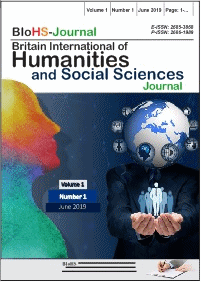Stereotypes and Prejudices in Communication between Chinese Ethnic and Indigenous Moslem in Medan City, North Sumatra Province – Indonesia
Abstract
There are still elements of stereotypes and prejudices, which cause social distance and become obstacles to the harmonization of relations between indigenous Moslem and Chinese ethnic in Medan city. Stereotypes are characterized by a variety of labels from each ethnic group, namely: Like to group; strong family ties; rude and arrogant; aggressive and ignorant of customs; like to steal; cunning and breaking promises; poorly educated; tenacious and likes to work hard; ethnic prejudice is expressed in various forms, namely: anti-residence; avoidance; discrimination; Intercultural communication between them which ultimately did not take place effectively, where each ethnic group still retains its ethnic identity and does not want to understand the culture of other ethnic groups. The communication that is intertwined ultimately is only pseudo, rigid and shallow. Stereotypes and prejudices are the main obstacles that cause among other things the existence of social distance and the difficulty of assimilation that inhibits the integration of society in the city of Medan and the Indonesian nation as a whole.
Downloads
References
Aronson, Joshua, Carrie B. Fried, and Catherine Good. (2002). “Reducing the Effects of Stereotype Threat on African American College Students by Shaping Theories of Intelligence.” Journal of Experimental Social Psychology 38(2): 113–25.
Bandura, Albert. (2001). “Social Cognitive Theory of Mass Communication.” Media Psychology 3(3): 265–99.
Baron, R.A., and D. Byrne. (1987). Social Psychology: Understanding Human Interaction. 5th ed. MA, US: Needham Heights, MA, US: Allyn & Bacon.
Batubara, M., U. et al. (2019). Islamic Communication Pattern of Judges in Dealing Conflict of
Muslim Families in the Religious Court Medan. Budapest International Research and Critics Institute-Journal (BIRCI-Journal). P. 373-386.
Bhagat, Rabi S., Ben L. Kedia, Paula D. Harveston, and Harry C. Triandis. (2002). “Cultural Variations in the Cross-Border Transfer of Organizational Knowledge: An Integrative Framework.” Academy of Management Review 27(2): 204–21.
Bodenhausen, Galen V, Geoffrey P Kramer, and Karin Siisser. (1994). “Attitudes and Social Cognition Happiness and Stereotypic Thinking in Social Judgment.” Journal of Personality and Social Psychology 66(4): 621–32. http://psycnet.apa.org/index.cfm?fa=search.displayrecord&uid=1994-29577-001.
Connaughton, Stacey L., and Marissa Shuffler. (2007). “Multinational and Multicultural Distributed Teams: A Review and Future Agenda.” Small Group Research 38(3): 387–412.
Crandall, Christian S., Amy Eshleman, and Laurie O’Brien. (2002). “Social Norms and the Expression and Suppression of Prejudice: The Struggle for Internalization.” Journal of Personality and Social Psychology 82(3): 359–77.
Epstein, Seymour. (1994). “Integration of the Cognitive and the Psychodynamic Unconscious.” American Psychologist 49(8): 709–24.
Fang, Tony, and Guy Olivier Faure. (2011). “Chinese Communication Characteristics: A Yin Yang Perspective.” International Journal of Intercultural Relations 35(3): 320–33.
Fiese, Barbara H., Kimberly P. Foley, and Mary Spagnola. (2006). “Routine and Ritual Elements in Family Mealtimes: Contexts for Child Well- Being and Family Identity.” In New Directions for Child and Adolescent Development, Wiley Periodicals, Inc.
Fiske, Susan T. (1993). “Controlling Other People : The Impact of Power on Stereotyping.” American Psychologist 48(6): 621–28.
Geertz, Clifford. (1973). “The Impact of the Concept of Culture on the Concept of Man.” In The Interpretation of Cultures, New York: Basic Books, Inc, 1–15.
Greenwald, Anthony G, and Mahrazin R Banaji. (1995). “Implicit Social Cognition: Attitudes, Self-Esteem, and Stereotypes.” Psychological Review 102(1): 4–27.
Guyll, Max, Stephanie Madon, Loreto Prieto, and Kyle C. Scherr. (2010). “The Potential Roles of Self-Fulfilling Prophecies, Stigma Consciousness, An...: Discovery Service for FRESNO PACIFIC UNIV.” Journal of Social Issues 66(1): 113–30. http://0-eds.a.ebscohost.com.librarycatalog.fresno.edu/eds/pdfviewer/pdfviewer?vid=1&sid=b1b61b35-5581-44c7-8ce4-7c209c416f87%40sessionmgr4006.
Hilton, James L, and William Von Hippel. (1996). “STEREOTYPES.”
Jost, John T., and Mahzarin R. Banaji. (1994). “The Role of Stereotyping in System‐justification and the Production of False Consciousness.” British Journal of Social Psychology 33(1): 1–27.
Kim, Young Yun. (2001). “Social Communication.” In Becoming Intercultural: An Integrative Theory of Communication and Cross-Cultural Adaptation, Thousand Oaks: SAGE Publications, Inc., 121–46.
King, Patricia M., and Marcia B. Baxter Magolda. (2005). “A Developmental Model of Intercultural Maturity.” Journal of College Student Development 46(6): 571–92.
Kunda, Ziva, and Steven J. Spencer. (2003). “When Do Stereotypes Come to Mind and When Do They Color Judgment? A Goal-Based Theoretical Framework for Stereotype Activation and Application.” Psychological Bulletin 129(4): 522–44.
Lewis, J. David, and Andrew Weigert. (1985). “Trust as a Social Reality.” Social Forces 63(4): 967–85.
Mannix, Elizabeth, and Margaret A Neale. (2005). “What Differences Make a Difference?: The Promise and Reality of Diverse Teams in Organizations.” Psychological Science in the Public Interest 6(2): 31–55.
Nagda, Biren A. (2006). “Breaking Barriers, Crossing Borders, Building Bridges: Communication Processes in Intergroup Dialogues.” Journal of Social Issues 62(3): 553–76.
Neuner, Gerhard, and Katarzyna Karwacka-Vögele. (2012). Intercultural competence for all: Preparation for living in a heterogeneous world Chapter One: Towards a Framework for Intercultural Education.
Ogbu, John U. (1992). “Understanding Cultural Diversity and Learning.” Educational Researcher 21(8): 5–14.
Padilla, Amado M., and William Perez. (2003). “Acculturation, Social Identity, and Social Cognition: A New Perspective.” Hispanic Journal of Behavioral Sciences 25(1): 35–55.
Pettigrew, Thomas F. (1997). “Generalaized Intergroup Contact Effect on Prejudice.” PSPB 23(2): 173–85.
PG, Devine. (1989). “Stereotypes and Prejudice: Their Automatic and Controlled Components.” Journal of Personality and Social Psychology 56(1): 5. http://web.comhem.se/u52239948/08/devine89.pdf.
Rafaeli, Sheizaf. “From New Media to Communication.” In Interactivity, , 110–34.
Spencer-Rodgers, Julie, and Timothy McGovern. (2002). “Attitudes toward the Culturally Different: The Role of Intercultural Communication Barriers, Affective Responses, Consensual Stereotypes, and Perceived Threat.” International Journal of Intercultural Relations 26(6): 609–31.
Ting-Toomey, Stella. (1984). “Intercultural Communication Theory: Current Perspectives.” International Journal of Intercultural Relations 8(2): 228–31.
Winkelman, Michael. (1994). “Cultural Shock and Adaptation.” Journal of Counseling & Development 73: 121–26.



.png)
_.gif)
















_.gif)














